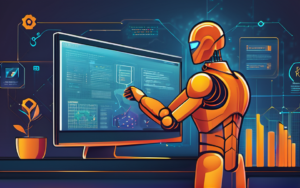Cybersecurity automation is transforming the way we protect our digital assets. From automating routine tasks to leveraging artificial intelligence (AI) for threat detection, automation is becoming increasingly prevalent in the cybersecurity landscape. But can cybersecurity be fully automated? Exploring the potential benefits and challenges of a fully automated cybersecurity approach is crucial for understanding the future of cybersecurity.
Introduction: The Rise of Automation in Cybersecurity
The rise of automation in cybersecurity is driven by several factors, including the increasing complexity of cyber threats, the growing volume of data, and the need to respond rapidly to incidents. Automation tools can help organizations to streamline security processes, improve efficiency, and free up security professionals to focus on more strategic tasks. While automation offers significant advantages, it’s important to consider the limitations and challenges associated with relying solely on automated systems.
The Benefits of Automated Cybersecurity
Enhanced Speed and Efficiency
Cybersecurity automation can significantly enhance the speed and efficiency of security operations. Automated tools can perform repetitive tasks such as vulnerability scanning, malware analysis, and incident response much faster and more efficiently than human operators. This allows security teams to respond to threats more quickly and effectively.
Improved Accuracy and Consistency
Automation can also help to improve the accuracy and consistency of security operations. Automated tools are less prone to human error and fatigue, which can lead to mistakes in manual security processes. Consistent application of security policies through automation can help to reduce the risk of vulnerabilities and breaches.
Proactive Threat Detection and Response
Automated tools can be used to proactively detect and respond to threats. For example, security information and event management (SIEM) systems can use machine learning algorithms to identify suspicious activity and trigger automated responses such as blocking access or isolating infected systems. This proactive approach can help to prevent breaches and mitigate the impact of attacks.
The Challenges of Full Automation
The Need for Human Expertise and Judgment
Despite the benefits of automation, fully automating cybersecurity is not feasible. Many aspects of cybersecurity require human expertise and judgment. For example, security professionals are needed to interpret the results of automated threat detection tools, investigate suspicious activity, and make informed decisions about how to respond to incidents.
The Risk of False Positives and Negatives
Automation tools are not perfect. They can sometimes generate false positives, which can lead to unnecessary alerts and wasted time. Conversely, they can also miss real threats, resulting in false negatives. Human oversight is essential to ensure that automated tools are effective and that threats are not overlooked.
The Potential for Automation to be Exploited
Automation can also be exploited by attackers. For example, attackers can use automated tools to launch denial-of-service attacks or to spread malware. It’s important to ensure that automated systems are secure and to have safeguards in place to prevent them from being used by attackers.
The Future of Cybersecurity: A Hybrid Approach
The Role of Automation in Enhancing Human Capabilities
The future of cybersecurity is likely to involve a hybrid approach that combines automation with human expertise. Automation will play an increasingly important role in augmenting human capabilities, enabling security professionals to be more effective and efficient. For example, automation can be used to collect and analyze data, identify potential threats, and recommend courses of action.
The Importance of Continuous Learning and Adaptation
The cybersecurity landscape is constantly evolving, and attackers are constantly developing new techniques. Therefore, it’s important for cybersecurity automation tools to be able to learn and adapt over time. This can be achieved through machine learning algorithms that can identify patterns in data and update their rules and models accordingly.
The Need for a Comprehensive Cybersecurity Strategy
A successful cybersecurity strategy requires a holistic approach that encompasses people, processes, and technology. Automation can play a crucial role in this strategy, but it’s not a silver bullet. It’s essential to have a comprehensive strategy that addresses all aspects of cybersecurity, including training, awareness, and incident response.
Balancing Automation and Human Expertise
Cybersecurity automation offers significant advantages, but it’s important to recognize its limitations. Fully automating cybersecurity is not feasible or desirable. A hybrid approach that balances automation with human expertise is the most effective way to protect against cyber threats.
The Importance of Ethical Considerations
As automation plays a greater role in cybersecurity, it’s important to consider the ethical implications. For example, it’s important to ensure that automated systems are used fairly and transparently and that they do not discriminate against individuals or groups.
The Future of Cybersecurity: A Collaborative Effort
The future of cybersecurity is likely to be a collaborative effort between humans and machines. By leveraging the strengths of both, we can create a more secure and resilient digital world. This requires ongoing investment in research and development, collaboration between industry and academia, and a commitment to ethical principles.




